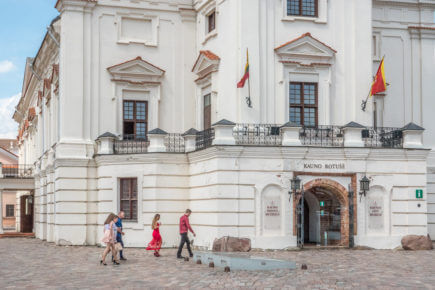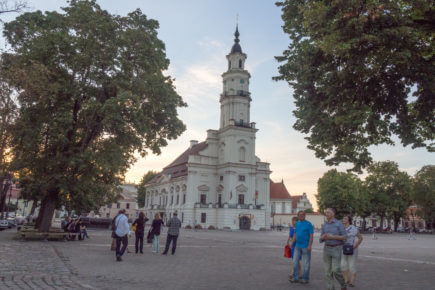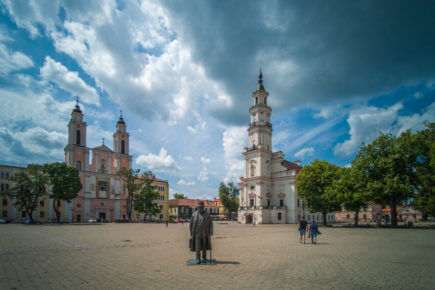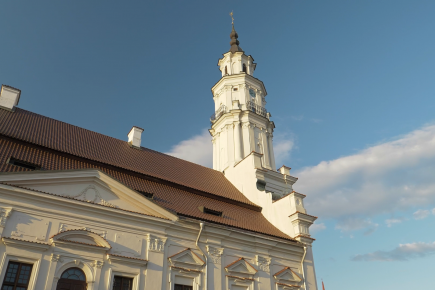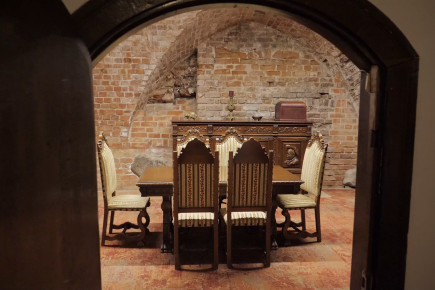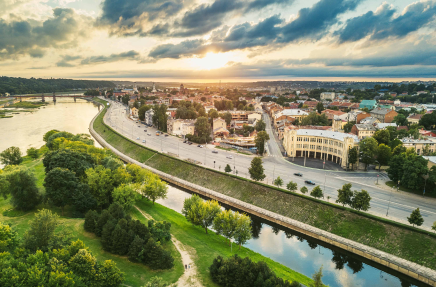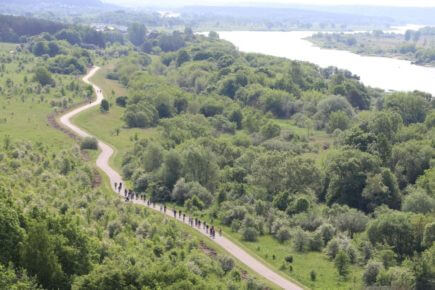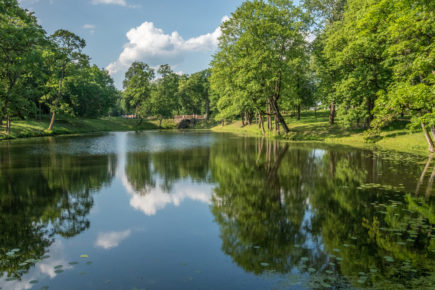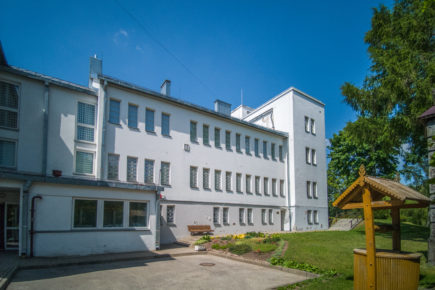Kaunas City Hall is like a swan stretching its long, white neck into the sky. This is how one often sees this unmistakeable part of Kaunas Old Town. The building is distinguished by its bright facade and unique architecture, which offers traces of Gothic, Baroque and early Classicism.
The graceful town hall tower that rises from the main façade is what makes the building resemble a swan. Looking at the White Swan, it is impossible not to admire its colour, which is similar to white ivory. The founding of the town hall, which is located near the confluence of the Nemunas and the Neris rivers, dates back to 1542. Around it you can find Kaunas Town Hall Square with the St. Francis Xavier (Jesuit) Church, the Zabiel House, the Sirutis Residence, the horse post office building complex, the Priests’ Seminary Rectorate Palace and the Church of the Holy Trinity. Historians believe the original Gothic structure built in 1562 was only one storey made of three naves, without a tower. It was later rebuilt, increasing in width and length. The Kaunas City Hall Tower is the tallest in Kaunas Old Town at 53 metres. The town hall is rectangular in plan, has two floors, a high attic roof and a six-storey tower. The building plan corresponds to the Renaissance style, though the decor has remained Gothic.
Like its architecture, the purpose of the town hall has also changed many times: the first floor was often used as a commercial premise, the second floor was reserved for the master and the board, and the basement was a prison where offenders awaited sentencing. Choinauskis led the town hall construction project, which began in 1542. By 1562, the building was said to be one storey with three naves, vaulted cellars, no tower, and no plastered facades. The second floor was built and an eight-storey tower was attached to the east side of the building in the second half of the 16thcentury.
In 1771-1780, architect Jonas Matekeris led another renovation project: the building was made taller, new cornices were built, the Gothic tower was divided into five stages from the outside and a sixth stage was built above them, and the building’s interior was redesigned.
In 1824, an Orthodox church was established in the former town hall, and later an artillery ammunitions depot. In 1838, the town hall was adapted for the Tsar’s temporary residence, adding Classicism features to the already-existing Gothic and Baroque styles.
Firemen used the building in 1850; from 1865 to 1869 the town hall was used as a theatre; from 1869 to 1944 it belonged to the Kaunas City Municipality; after the Second World War it was used as the Kaunas Branch of the Central State Archive; in the period between 1951 and 1960 it was managed by the Faculty of Civil Engineering of Kaunas Polytechnic Institute.
The Town Hall Square ensemble was redesigned in 1932. In May of 1967, a project proposal was put forth for the restoration and adaptation of the Town Hall to the Marriage Palace. From 1968 to 1973, the building was restored by architect Žibartas Simanavičius. The premises on the first and second floors were turned into the Marriage Palace in 1974, and the Museum of Ceramics was set up in the basement.
Before entering the Town Hall, one can see an authentic wax-melting furnace on the right dating back to the 15th century. This furnace symbolises how for many years the Town Hall was brought together by talented craftsmen who created thousands of unique artefacts. There were once as many as eight stoves in the market square. This furnace shows the 15th-century pavement – revealing how the cultural layers grew – and is a great example of how the city used to function. This furnace is also reminiscent of an important period when the Town Hall Square was part of the Hanseatic Way.
Kaunas is the only Lithuanian city directly related to the Hanseatic League. A merchant office of Hanseatic cities was formed in Kaunas during the reign of Kazimieras Jogailaitis, giving it the right to have warehouses in the city. The office operated from 1440 to 1536. The historic symbols of the political and cultural union are the former warehouses of goods, the so-called Hanseatic Warehouses, located on the corner of Museum and Santaka streets.
Many products were once manufactured in the Town Hall Square, which were traded in Lithuania and throughout the Hanseatic Way. Nowadays, the Town Hall Square traditionally hosts Hanseatic Days, combining culture, music, art, trade and crafts to commemorate the importance of the Hanseatic Way.
The Kaunas City Museum is currently housed inside the Town Hall. The museum provides an overview of the history of Kaunas, as well as the stories told by us and our ancestors, heard and seen in the city square or at home, famous or unknown to anyone. Once upon a time on a hunting expedition, a group of Lithuanians managed to trap a forest auroch at the confluence of the Lithuanian river father Nemunas and mother Neris (present-day Kaunas). At this point the beast was pierced with a spear. The hunters soon noticed that a cross formed from a tree branch between the thick horns of the animal. The ancient Lithuanians were afraid of the wrath of the gods and decided to sacrifice the animal to the forest. They made a great bonfire of oak trees and sacrificed the beast in the bright moonlit night in honour of their majestic gods.
Another legend says that Kaunas was founded by Roman patricians who fled the tyranny of Emperor Nero. According to Albert Vijūkas-Kojelavičius, the leader of one of those families, Duke Palemonas and his sons sailed along the Nemunas and reached the territories of Kaunas, where there was only a simple village with several huts. There, his son Kūnas (Duke Kaunas, called Kūnasijus or Kūnarijus in other writings) established a city. According to a further legend, the founder of the city died in a fight against the Kievan Rus’ after falling into the captivity of Duke Mistislav.
The authenticity of the Town Hall’s interior has been largely preserved The interior is quite ornate; curved shapes, shining details and red carpets dominate the inside. There are also plenty of paintings that portray significant historical events and the personalities who contributed to the spread of the Town Hall Square.
Inside the Town Hall Tower, the stairs lead up to the tower clock, which dates back to the 1780s when then-mayor of Kaunas Henrik Essen ordered the production of a clock with bells for the newly rebuilt Town Hall Tower. In 1907, the clock was replaced with a new one made in St. Petersburg. Later, the clock’s mechanisms were likely taken to the Moscow Polytechnic Museum and replaced by an electromechanical clock. Following the latest repair of the mechanism, which was already being controlled by a computerised system in 2016, the mechanisms started to get stuck and had to be finely adjusted by hand. Today, thanks to new mechanisms from Germany, the clock tower’s bell, which is struck by a 2 kg hammer, is once again marking the hour for townspeople and guests of the city.
The town hall has an observation deck that offers a panoramic view of the old town. Visitors can also go to the top of the Kaunas City Hall tower during the pre-holiday period.



